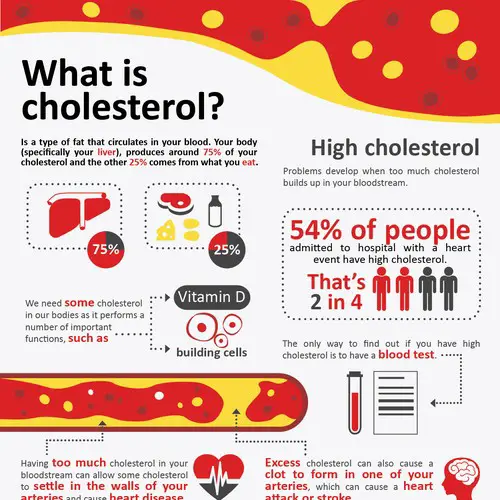Cholesterol is a waxy and soft fat that assists the body in performing its natural functions. As with many aspects of the human body, excess and imbalances cause more havoc than assistance.
When fats are absorbed in the intestines, they get processed and then filtered to the liver. While in the liver, the fats are split into two types referred to as triglycerides and cholesterol.
The bloodstream delivers LDL and HDL proteins throughout the body. This process goes without disturbance just as long as the body is not under any immediate stress.
The fats need a mechanism to allow their distribution for immediate use or for storage in fat cells (to be used later). Using the bloodstream as a delivery system, cholesterol and triglycerides are distributed throughout the body by proteins called lipoproteins. There are three types of lipoproteins: Low Density Lipoproteins (LDL), High Density Lipoproteins (HDL), and Very Low Density Lipoproteins (VLDL).
Cholesterol comprises cell walls and membranes, and aids in the production of hormones, bile acids and vitamin D. It’s also supposed to support the cell connections in the brain that are responsible for memory and learning.
The human body is naturally able to produce the amount of cholesterol that is needed on a daily basis. When cholesterol level rises in the blood, it causes more harm than assistance.

Too much cholesterol deposits by LDL narrows the blood vessels which restricts blood flow. This cholesterol may attach itself to the heart’s arteries – a common factor in strokes or heart disease. This is also known as atherosclerosis – the process of bad cholesterol formation within organ structures.
This is why LDL is labeled as ‘bad cholesterol’. On the other hand, HDL is known as ‘good cholesterol’. It works in the opposite way, by actually taking ‘bad cholesterol’ back to the liver.
There are many factors such as diet, heredity and exercise that affect one’s cholesterol level. It’s important to be aware of the health risks associated with high cholesterol.
Make it a habit to check your cholesterol level on a regular basis.
How Does Cholesterol Work?
If an artery is damaged, it invites the cholesterol to attach to its inner lining. Cholesterol will also accumulate in the cells surrounding the damaged artery. In the mean time, white blood cells, calcium and cellular debris accompany cholesterol to the site of damage within the artery.
Accumulated fat will continue to build into a bulge in the artery which results in the formation of scar tissue – a hard, shell-like covering fusing cholesterol and cellular structures. Cholesterol trapped by the scar tissue results in plaque.
A decrease in the supply of oxygen and cellular nutrients to the tissues is a characteristic of the buildup of plaque. It is caused by the narrowing of the artery which restricts the flow of blood and essential molecules.
The decrease in blood and oxygen supply leads to the reduction of elasticity of the blood vessels and can compromise the ability of the arteries to control blood pressure. If the narrowed arteries do not have enough oxygen in the blood flowing through, you may feel a certain pain.
The pain, called angina, originates from the heart and it usually occurs during times of stressful activities such as exercise. This is due to the fact that the heart requires more oxygen and can detect the lack of. Patients usually report feeling a pain in the left arm and shoulder, or chest region. Unfortunately, this process can sometimes happen without any tell tale symptoms.
Doctors usually perform tests to determine blockage and to identify heart disease. Since plaque varies in shape and size, some of the many small ones can be missed by these tests.
Because of their size, larger plaques used to garner the most attention. They were considered to cause more harm because of the likelihood to completely block the coronary arteries.
While angina is generally caused by large plaques, it is the smaller plaques that the medical community considers the more dangerous. If a smaller plaque is unstable and ruptures, it releases its contained cholesterol into the bloodstream. Clotting of the artery immediately follows the rupture. Blood clots could be large enough to completely stop the blood flow and produce a heart attack
Image : medicalnewstoday.com

